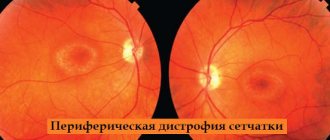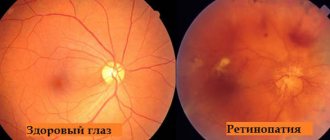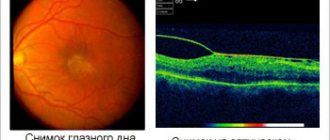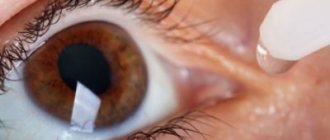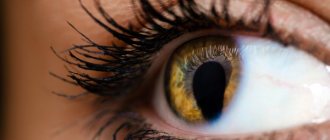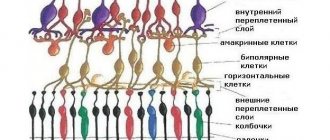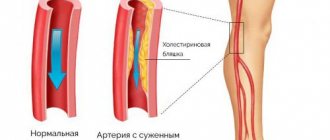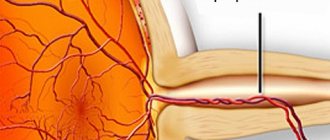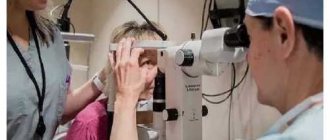This type of peripheral dystrophy is usually detected in people with progressive axial myopia and pathological changes in blood vessels in the fundus.[1]
Its cause is morphological changes in blood vessels with the formation of slightly shiny white patches (short stripes) and small areas of thinning of the retina, as well as hole defects.
The pathology is visualized as a trace from a crawling snail, which became the basis for its name.
As the pathology progresses, the lesions begin to merge with the formation of ribbon-like areas of dystrophic changes.[2]
Fig. 1 View of foci of dystrophy in the fundus
Typically, this disease is localized in the upper outer region of the eye. Its characteristic feature is the gradual formation of large round-shaped tears.
The risk of retinal detachment in trace cochlear dystrophy is very high, it is significantly higher than in other peripheral degenerations. However, the prevalence of this type of pathology is significantly lower than that of “lattice dystrophy,” which affects 8% of people.[3]
Causes
Patients with a history of myopia are susceptible to developing the disease. This is due to an increase in the length of the eyeball, which leads to tension in the retina and its thinning.
Lattice degeneration occurs due to the following reasons:
- problems with blood circulation in the inner lining;
- infectious diseases;
- intoxication;
- accumulation of metabolic breakdown products with age;
- pathological conditions of the endocrine glands.
Lattice degeneration also forms during gestation and with cardiovascular pathologies.
It is more often diagnosed with myopia, diabetes mellitus, injuries of the visual analyzer and inflammatory conditions.
Through the eyes of a clown, a snail and Mary Magdalene
Alexander Markov
What have pictorial conventions done to us?
Arass D. The snail's gaze: descriptions of the non-obvious / trans. Elizaveta Kuznetsova, edited by Igor Bulatovsky. M.: Ad Marginem Press, 2019 The French art critic Daniel Arasse (1944–2003) was a legend during his lifetime: special issues were dedicated to him by French intellectual magazines, which usually do not trust art critics and their seemingly petty disputes too much. Disabled from his youth, in poor health, he fought for life and for art, and shortly before his death he gave lectures on the radio that formed his posthumous book, “Histories of Canvases.” The trusting tone in it is captivating: the specialist tells how he fell in love with paintings and how he understood that paintings think. For example, in one of Vermeer’s paintings, he noticed a highlight on a loaf of bread - this does not happen in nature. But this is not a fantasy, Vermeer simply painted with very thin brushes and at the same time created an almost impressionistic blurriness effect, and a highlight is needed to make this productive illusion even stronger.
Pontormo. Descent from the Cross. 1525–1528. Altarpiece in the Capponi Chapel of the Church of Santa Felicita in Florence.
Both in this posthumous book and in the book “Detail in Painting” (1992, Russian translation 2010) known to Russian readers, Arass insists that artists write not for art critics or for the market, but for an attentive viewer who is able to relate what is depicted to what is happening around . At the same time, the viewer is not required to have sharp eyesight and a tenacious memory, but on the contrary, even the blind will see that it is impossible not to see. For example, Arass asks why in Pontormo’s “Descent from the Cross” there are such unnatural colors and the composition resembles a tower of acrobats? Yes, because the picture was painted under the fresh impression of the Sacco di Roma, the sack of Rome by the troops of Charles V in 1527, after which Protestantism became a political force not only in the German lands, but throughout Europe. Pontormo, according to Arass, offers an intellectual answer: amid unthinkable events, shaking the foundations, art should become as unnatural as possible, only then it will not only reflect the intentions of artists and spectators, but will create a historical feeling, without which humanity will perish in internecine wars. Arass was the first art critic to talk not just about the effects of an artistic form with its conventions (how aerial perspective affects worldview has been talked about for almost a hundred years), but also about the effects of the conventions themselves.
Where is the snail crawling?
The book “Descriptions of the Unobvious” (2000, in Russian translation one of the essays gave the title to the entire book) is several stories about what the audience and characters in the paintings see. What does the snail see crawling along the very edge of the altar of the Annunciation by Francesco del Cossa (1470)? What do the Magi see in “The Adoration of the Magi” (1564) by Bruegel of Muzhitsky, the frail old men who can barely stand on their feet? What does Velázquez see if he does not just paint a self-portrait in his Las Meninas (1656), inserting himself into the composition, but rewrites it after receiving the order? What do we see ourselves when we look at Titian’s “Venus of Urbino” (1538), if we cannot understand not only who exactly is in front of us, but, say, whether the feather beds are lying on the floor or on the bed? Typically, art critics do not ask such questions: they believe that the artist builds a composition, providing it with effects based on expediency. But Arass himself, who could barely walk due to disability, sensitive to color to the point of irritation, could not talk about the paintings except by feeling the morbidity of what seems natural.
Diego Velasquez. Meninas (fragment). 1656 Prado Museum, Madrid. On the left, the artist depicted himself
Titian. Venus of Urbino. 1538 Uffizi Gallery, Florence
Francesco del Cossa. Annunciation. 1470–1472. Art gallery, Dresden
Here is a snail in the composition of the Annunciation - it would seem to be an optical illusion (trompe-l'œil), but if you want to brush away the apparent fly (and Arasse admits that, despite all his qualifications, he became a victim of trompe l'oeil in the museum), then you cannot simply remove the snail. Not because it’s a pity to touch it, unlike a fly, but because an iconologist will come and say that in certain medieval sources a snail is one of the symbols of the incarnation of God, which means it’s better not to touch it. Iconology immediately declares whatever it encounters as a symbol and an allegory. Arass does not like allegories in general; for him they only interfere with our adventures in the world of painting.
But maybe the snail is a symbol of the slow flow of history before the Incarnation, when the creature groaned in torment and did not find salvation? Some art critic will immediately draw a line from God the Father in heaven to a snail on earth. But what to do with the fact, Arass asks, that the snail turns out to be disproportionately large, the size of an archangel’s foot. The researcher, whose feet always hurt and went numb, especially feels this. Therefore, he comes to the conclusion that the snail exposes the illusory nature of painting, shows that the mystery of the incarnation cannot be conveyed by any pictorial means, painting will always lean towards allegory, while true art, shining through the clothes of brilliant painting, is felt only by a snail that does not distinguish between objects, but only light and warmth. The snail is not a movement towards progress, but our own progress, the ability to see pictures not with the curious gaze of a tourist or the profit-conscious gaze of an artist, but with the lonely gaze of one who is looking for something unconditional in the world.
Ham turns into a Christian
In Heinrich Böll’s novel “Through the Eyes of a Clown,” the protagonist’s agent Tzotsener turns out to be the only real Christian, and only with him does Hans want to talk again. The book that taught us to see through the eyes of a snail also talks about a simple desire that is stronger than any moral exhortation. Arass boldly reclassified Renaissance paintings, which had previously been considered a wedding gift, into paintings for the salon of courtesans: they speak not of female infidelity, but rather of the blindness of passion, of its warm bodily sensation. For example, Tintoretto’s painting “Venus, Vulcan and Mars,” the dating of which is unclear and the circumstances of its origin unknown, receives an explanation for this lack of documentation: it simply belonged to a courtesan. Vulcan (Hephaestus) is just about to take possession of his legitimate wife, but in the mirror he is already in full swing: doesn’t this show how blind passion is and can only see itself in the mirror, just as a snail can see the world only when it comes out into the light , to the forefront of the picture? Therefore, the painting teaches not how cunning women can be, which would be appropriate for a gift to a man, but that in a courtesan’s salon you must quickly become infected with passion, even before you have time to understand the plot of the picture.
Tintoretto. Venus and Mars caught by Vulcan. Around 1555. Alte Pinakothek, Munich
Titian. Penitent Mary Magdalene. Around 1531. Palazzo Pitti, Florence
Already in this essay on Tintoretto, which opens the book, Arass distinguishes between two Italian terms - serio and serioso. It is difficult to translate this difference into Russian, but in English trust and belief do not coincide. The difference between the terms is the same: a natural impulse towards justice and an intellectual recognition of the justice of such a state of affairs. The Russian words seriousness, severity, severity, fidelity do not provide the necessary shades of meaning, without which the concept of Arass is difficult to understand. Indeed, the picture is serious in the sense that it awakens in us an immediate impulse, an erotic one, a desire to look into a forbidden area, to see the invisible, to recognize something illegal. But the painting as a part of painting, as an institutionalized object, is serious in the second sense; it requires us to recognize our own boundaries, the historical conditions in which we ourselves have to act. For example, seeing Titian’s “Magdalene”, her seemingly bleached hair, we understand that we can see Magdalene’s body only covered with hair, and therefore recognize Magdalene’s spiritual feat regardless of what erotic attraction she awakens.
Pieter Bruegel the Elder. Adoration of the Magi. 1564 London National Gallery
Or in the scene of Bruegel’s “Adoration of the Magi” an African sorcerer appeared, who had long existed in legend. But, as the art historian proves, without him this picture could not have taken place as a social and political phenomenon: after all, Constantinople had recently fallen, and Europe began to look for a new route to Jerusalem through Africa. Therefore, in the minds of people, even before the establishment of relations with Ethiopia, an African Christian state should have appeared. But it was also necessary to prove that these were true Christians who would become not temporary allies, but permanent ones, as Böll’s hero becomes convinced that only the agent, who demands that he quickly stop drinking and do physical exercise, treats him rudely, but better than all the imaginary Christians from his friends.
In Bruegel's analysis, Arass also notes a similar transformation of a boor into a Christian. According to medieval legend, Africans descended from Ham, who ridiculed his father's nakedness. The descendant of Ham looks at the infant Christ, sees the mark of circumcision, not shown to the viewer, but shown to him, and is convinced of the dogma of God-manhood. So he begins with curiosity, with seriousness in the first sense as intense vision even with blind eyes. But suddenly he ends with seriousness in the second sense - responsibility for the composition of the picture, for the stability of the established peace in the era of Christmas, during the reign of Augustus. A painting that stops wars? Yes, in much the same way that a bright propaganda formula starts a war by infecting people, the invisible formula of art stops it in the same way.
Artists at that time did not know how to depict circumcision, lacking book examples and medical experiments. But the invisible in painting turns out to be better than the visible as an instrument of that fidelity to nature, which alone can restore the world. Now, in the age of ecological, participatory, social art, we can increasingly think about the invisible, which turns out to be the only justification for the visible. Looking at the screen of a video installation, at minimalist sculpture, at pop art, we will see the skill of Bruegel and the unsurpassed virtuosity of Titian. Then the book came true, the book is already working.
The Russian edition of the book pleases with its good publishing culture: thoughtful design, high-quality reproduction of fragments of paintings, rounded font and large margins. The only thing that confuses us is that the footnotes are too short, for example, an explanation in the spirit of “Max Dvorak - Austrian art historian” says nothing about the fate of the Viennese school of art history. But this minor drawback is completely covered by the merits of the translation and editorial preparation.
Alexander Markov , Dr. Philol. sciences
If you find an error, please select a piece of text and press Ctrl+Enter.
Tags: #294, Alexander Markov, Daniel Arass, painting, art, history, picture, culture, worldview, artist
See also:
- Evidence of Piero della Francesca (01/15/2019)
- Russian avant-garde - projects and projections (01.11.2016)
- Art and memory (25.09.2012)
- Yuri Larin: counterpoint of figurative and color-plastic (04/19/2016)
- Chemistry Nikichey. The mystery of one painting (05/08/2018)
- Three hypostases of Marinism (22.10.2019)
- Realism driven to despair (03.11.2020)
- Under the control of the drawing (09/26/2017)
- From Russian icon to Soviet poster (06.06.2017)
Symptoms
The pathological condition is characterized by the appearance of degenerative foci in the form of ribbon-like zones. Outwardly, they resemble a snail's footprint. Due to the thinning of the retina tissue, large round tears may form.
The dystrophic process is clearly defined in the equatorial zone parallel to the dentate line. It is a cluster of shiny dots in the shape of boats.
The disease is practically asymptomatic. You can detect a trace of a snail during the next random examination of the patient. The victims themselves go to the hospital when a rupture has already occurred, since in this case the clinic is noticeable and worsens.
Clinical picture:
- visual perception deteriorates;
- floaters appear before the eyes;
- parts of the field of view fall out;
- bright flashes appear;
- a curtain appears.
Further progression of the disease leads to blurred and wavy images, and the appearance of shadows in the lateral part of visual perception.
Clinical manifestations of retinal detachment
Clinical picture of retinal detachment
quite typical.
The precursors of detachment
are the appearance of light phenomena: “flashes,” “sparks,” zigzags, “lightning.”
These phenomena ( photopsia
) indicate the presence of irritation of the photosensitive cells
of the retina
caused by traction from
the vitreous body
.
They are especially visible when your eyes
. To diagnose emerging lesions, it is important to remember the location of these symptoms and report this to the ophthalmologist.
Floating opacities often occur
(or the number of existing ones increases significantly) in
the field of view
.
The degree of severity varies from many “black dots” and “soot flakes” to floating “lace” or a black “curtain” in front of the eye. Their appearance is associated with damage to the vessels of the retina
when it
ruptures
, followed by hemorrhage into
the vitreous body
.
Floaters _
in the form of “soot flakes” and the appearance of a “dark curtain” are the initial signs of developing
retinal detachment
. The appearance of these two symptoms usually coincides in time, but floating opacities
may appear several days after outbreaks.
It should be noted that the above symptoms are a manifestation of traction
from
the vitreous body
.
Therefore, due to the increased risk of developing retinal detachment
, if such complaints arise, it is advisable to immediately contact an ophthalmologist for a preventive examination of the extreme periphery of the fundus with a wide pupil.
A timely visit to an ophthalmologist
will make it possible to identify a complicated version of the course of
vitreous detachment
, to carry out
laser coagulation
(see below) of
retinal
and will help to avoid the development of severe consequences
of detachment
.
In case of traumatic brain injury, fall from height, direct eye
even in the absence of any complaints from the organ of vision, consultation with an ophthalmologist is
necessary
.
An examination by a specialist will identify breaks
and initial signs
of retinal detachment
, and preventive
laser treatment
will prevent its further progression.
To more rare symptoms of retinal detachment
include
pain in the eye
, which occurs at the moment of formation of
a rupture
due to a sharp pull (
traction
)
of the vitreous body
onto the ciliary
body
, which has rich sensory innervation (
the retina
does not have pain receptors).
Further progression of retinal detachment
accompanied by the appearance of a black “
curtain
” in front of
the eye
, gradually occupying an increasing part
of the visual field
.
a black curtain looks like
", descending from the periphery to the center during
retinal detachment.
The time during which a significant narrowing
of the visual field
and central
vision
largely depends on the location of
the retinal tear
.
When the gap
in the lower half
of the fundus, retinal
detachment can progress slowly (also depends on the functional state
of the vitreous
), over several weeks and even months, without causing defects in the
visual field
.
Detachments
with this location
of the gap
are very insidious - they are often detected only when
the macular area
, which significantly worsens the prognosis regarding visual functions.
On the contrary, if a retinal tear
located in the upper half
of the fundus
(and this is most common), progression
of retinal detachment
can occur very quickly (within a few days).
The fluid that accumulates under the retina
, due to its higher specific gravity, gradually sinks lower and lower, exfoliating
the retina
over an increasingly larger area.
If no action is taken, this process will lead to the involvement of all quadrants of the retina
, including
the macular area
(total, complete
retinal detachment
).
When involved in macular
There is a distortion of the shape and size of objects, their curvature and oscillation, followed by a sharp decrease in central vision.
Retinal disinsertion
involving
the macular region
Defects in the visual field
very diverse and changeable.
In the morning hours, some improvement in
visual functions may be noted, since during sleep in the supine position, part of the fluid is absorbed, and
the detachment
can adhere on its own.
When taking a vertical position, the situation repeats itself and the symptoms described above reappear. This symptom of temporary improvement in visual function is characteristic only of “fresh” retinal detachment
.
When a detachment
in the
retinal
; it gradually loses its elasticity, becomes inactive, and can no longer lie down in place on its own.
Treatment
Lattice degeneration is treated with conservative and laser methods. Surgical treatment is used less frequently because the recovery period is long and a hospital stay is required for the first 1–2 weeks.
Medicines include antibiotics, anti-inflammatory and moisturizing drops. Treatment is also supplemented with vitamin complexes.
Treatment of a dystrophic condition using physiotherapeutic methods allows medications to be better absorbed into the tissue. Physical therapy is used if there is no tear.
Laser treatment is carried out using new laser devices. They irradiate the damaged area. The procedure does not last long. Takes only 4–10 minutes for each eye. Laser therapy can improve visual perception by 70% if the disease is detected at stages 1–2 of development.
If the retina ruptures, surgery is required. Extrascleral ballooning or filling is performed. The main goal is to achieve adherence of the retina to the choroid. Then laser strengthening is performed.
If necessary, repeat laser treatment is prescribed. This will help consolidate the results obtained and check the progress of the recovery process.
Prevention
The main way of prevention is to monitor your health. In the presence of diseases that can lead to dystrophy of the “snail trail” type, carry out timely treatment and prevention.
It is also important to diagnose the pathological condition in a timely manner. It is necessary to visit an ophthalmologist at least 2 times a year and check the visual system. This especially applies to patients with poor circulation, diseases of the cardiovascular system, myopia and those over 45 years old.
Diagnostics
In most cases, to make a diagnosis, it is enough to examine the fundus with a wide pupil (ophthalmoscopy with a Goldmann lens). In some cases, additional methods may be required, for example, optical coherence tomography of the retina. [4]
Fig. 2 Optical coherence tomography (OCT) image of cochlear track dystrophy: thinning with wrinkled inner surface of the retina
